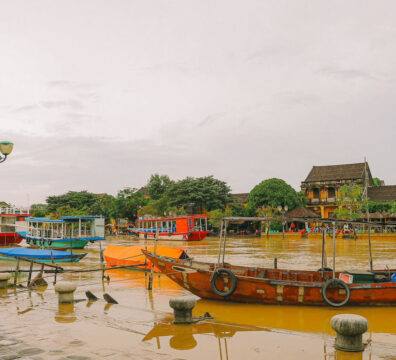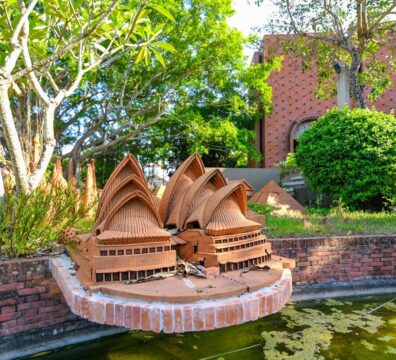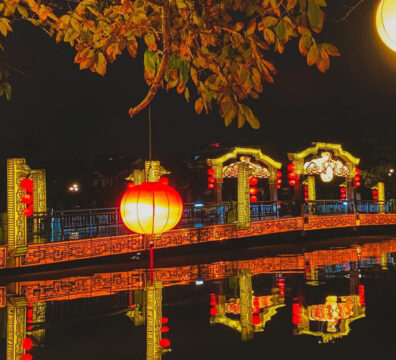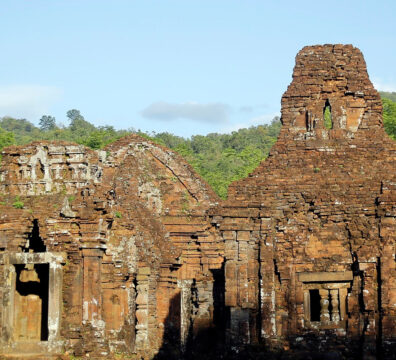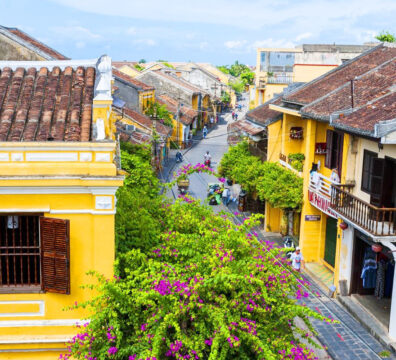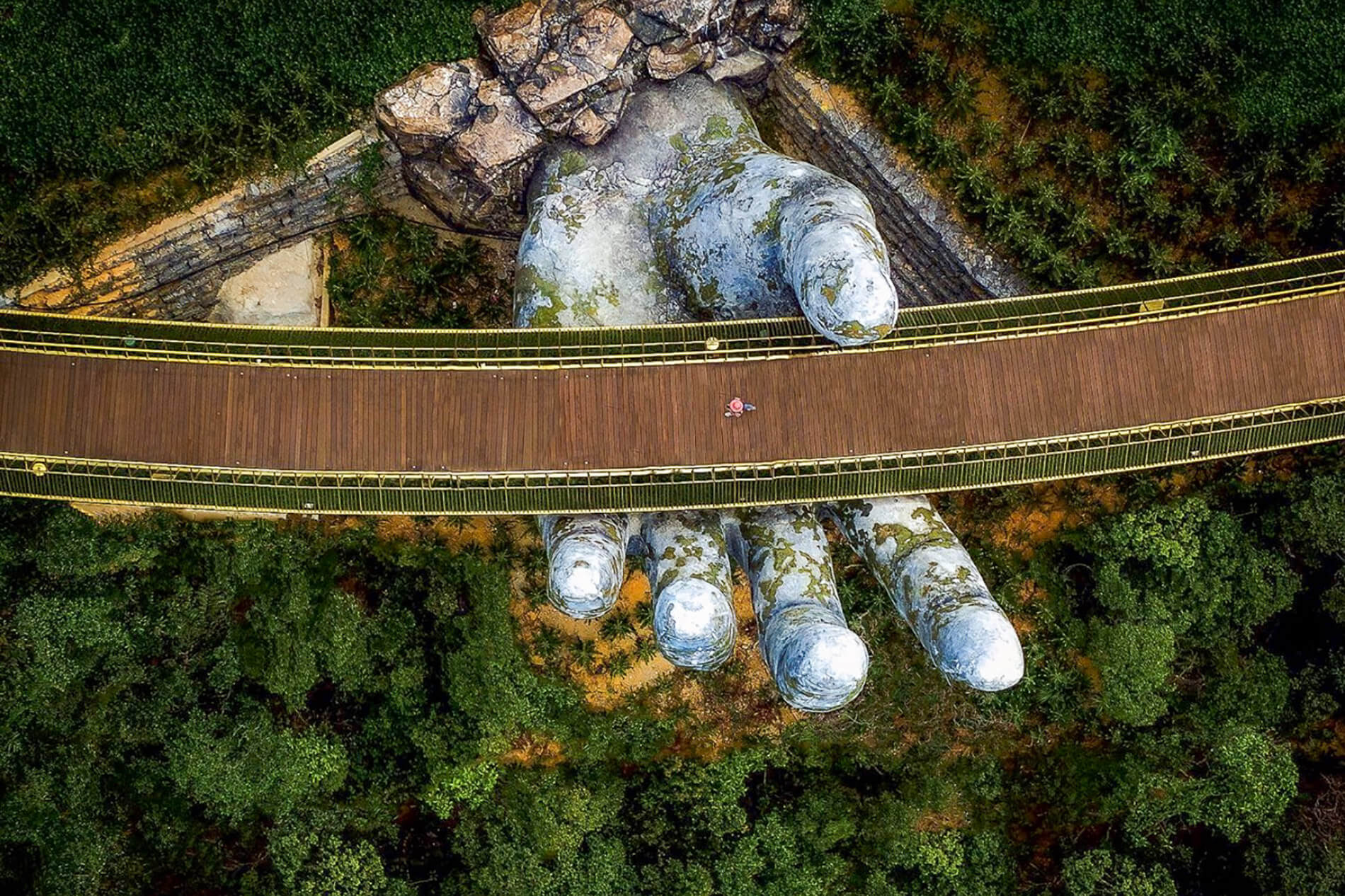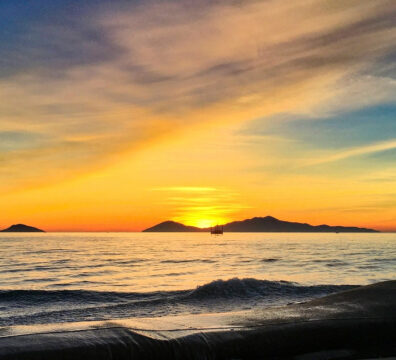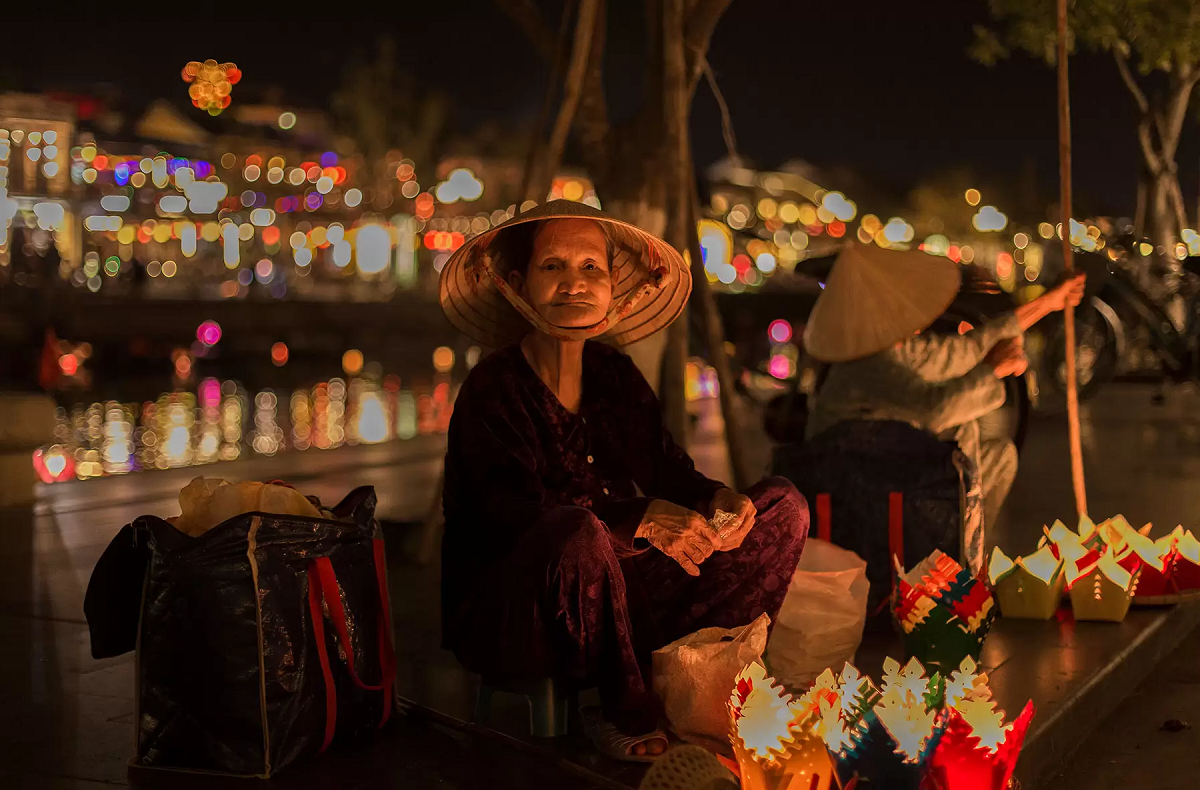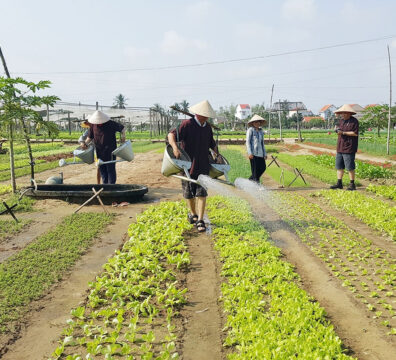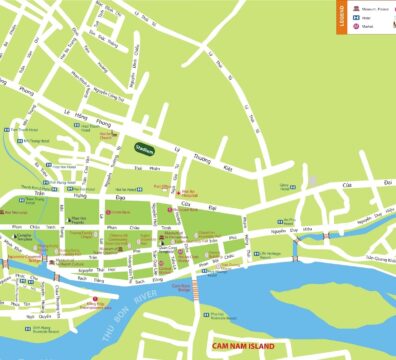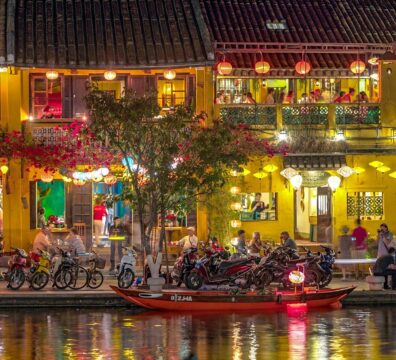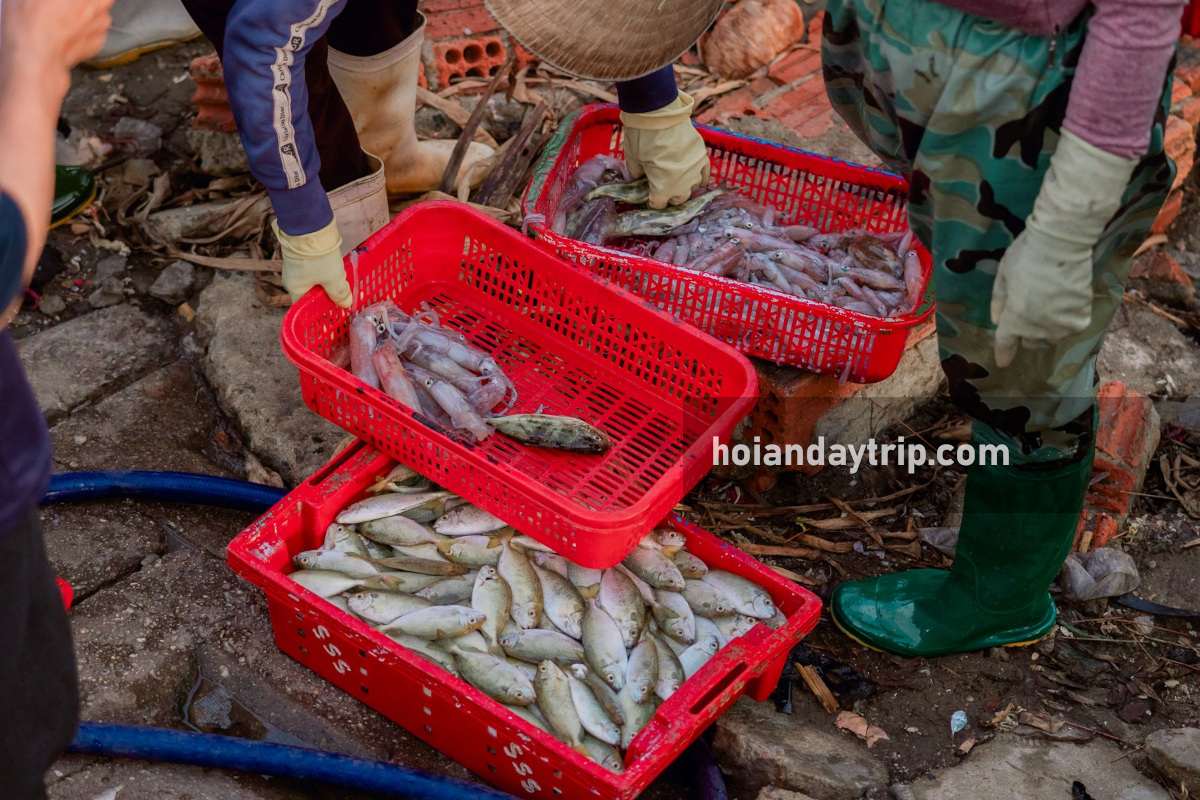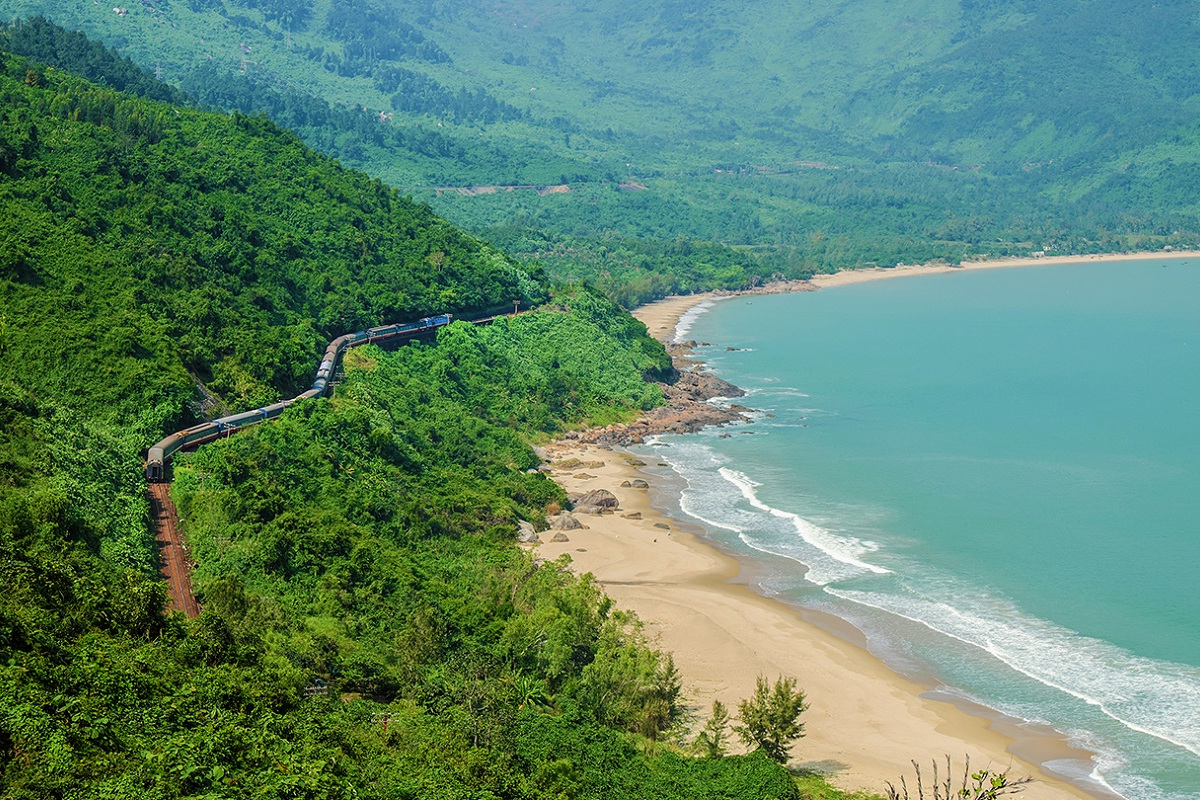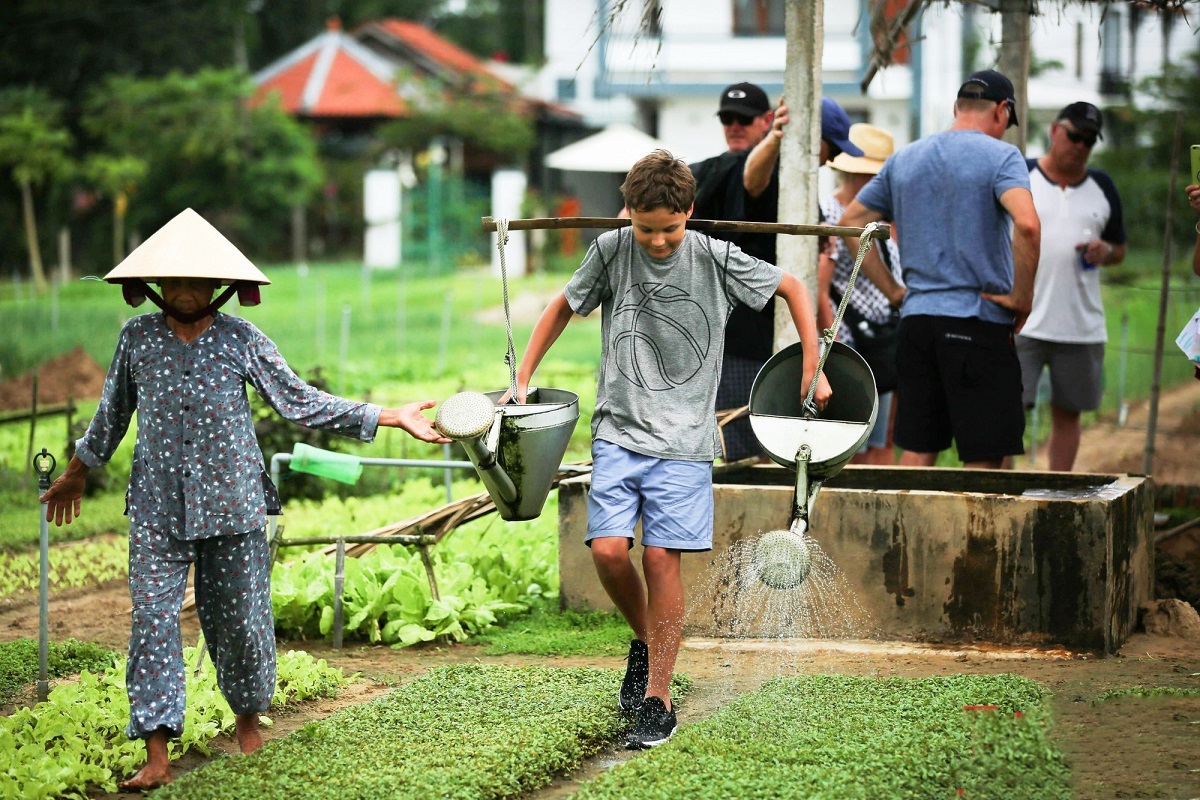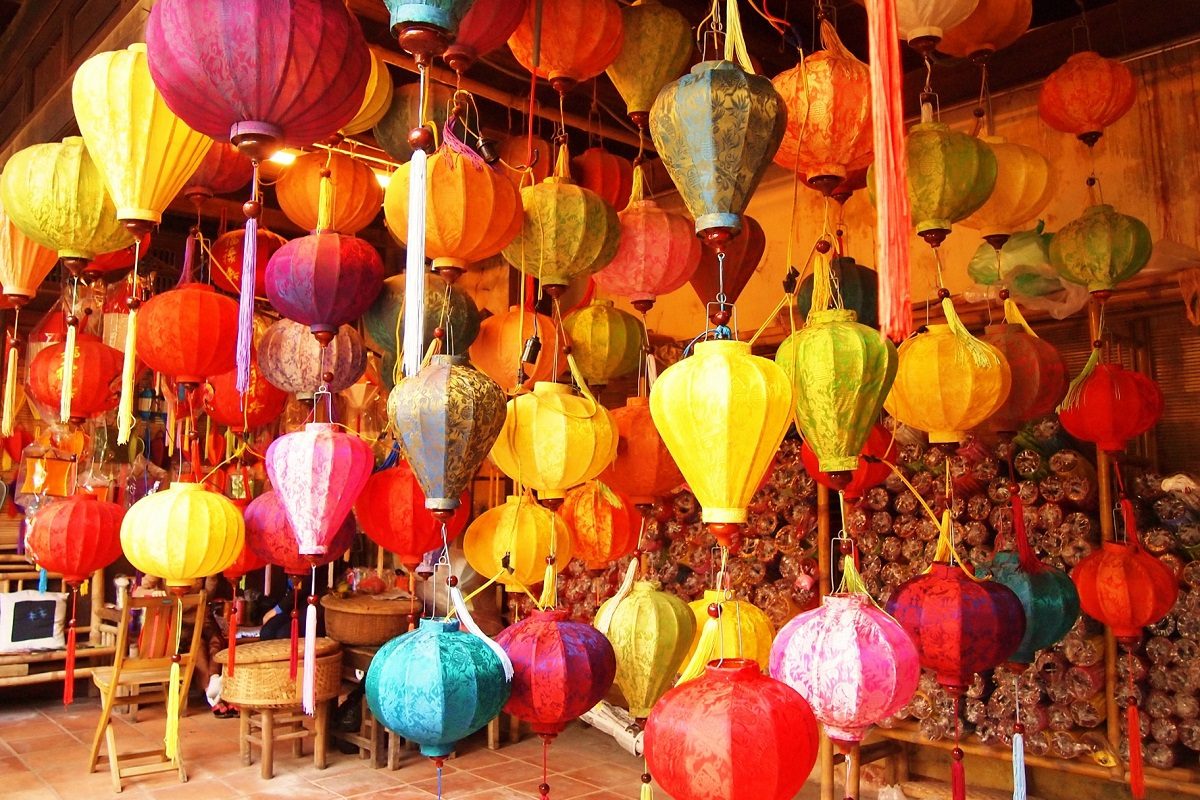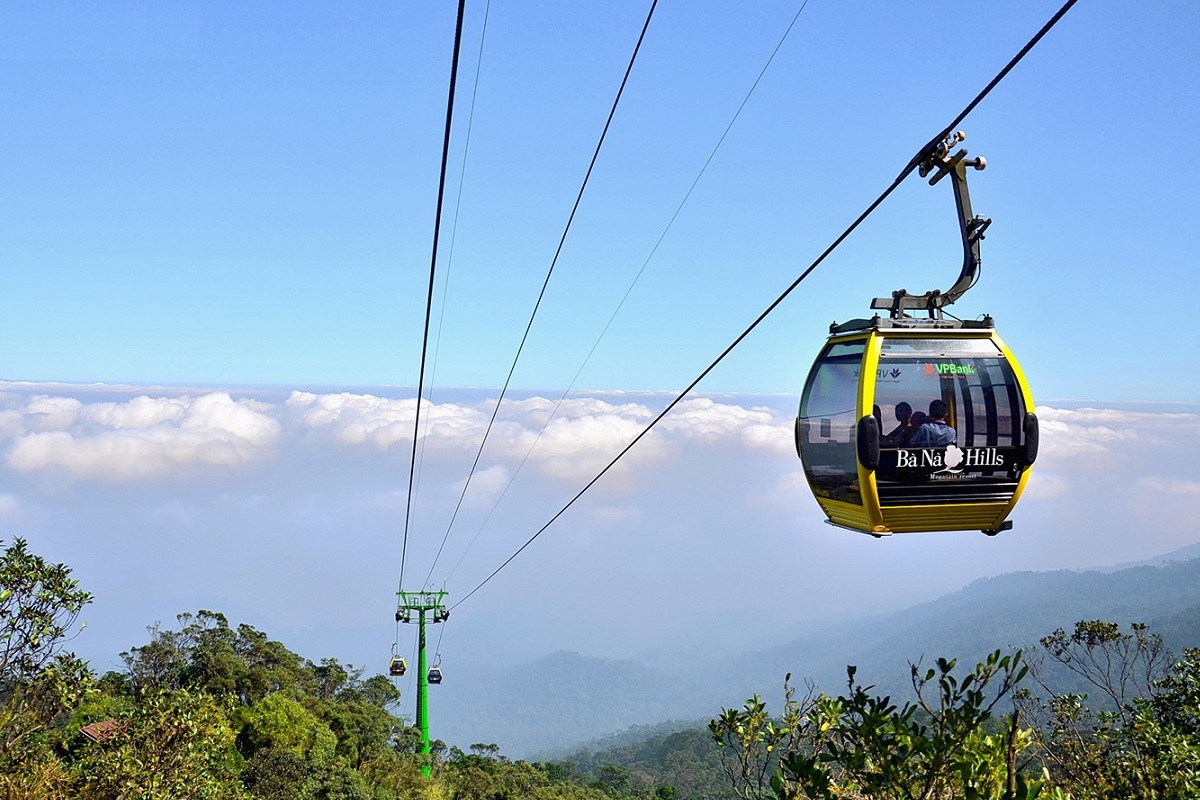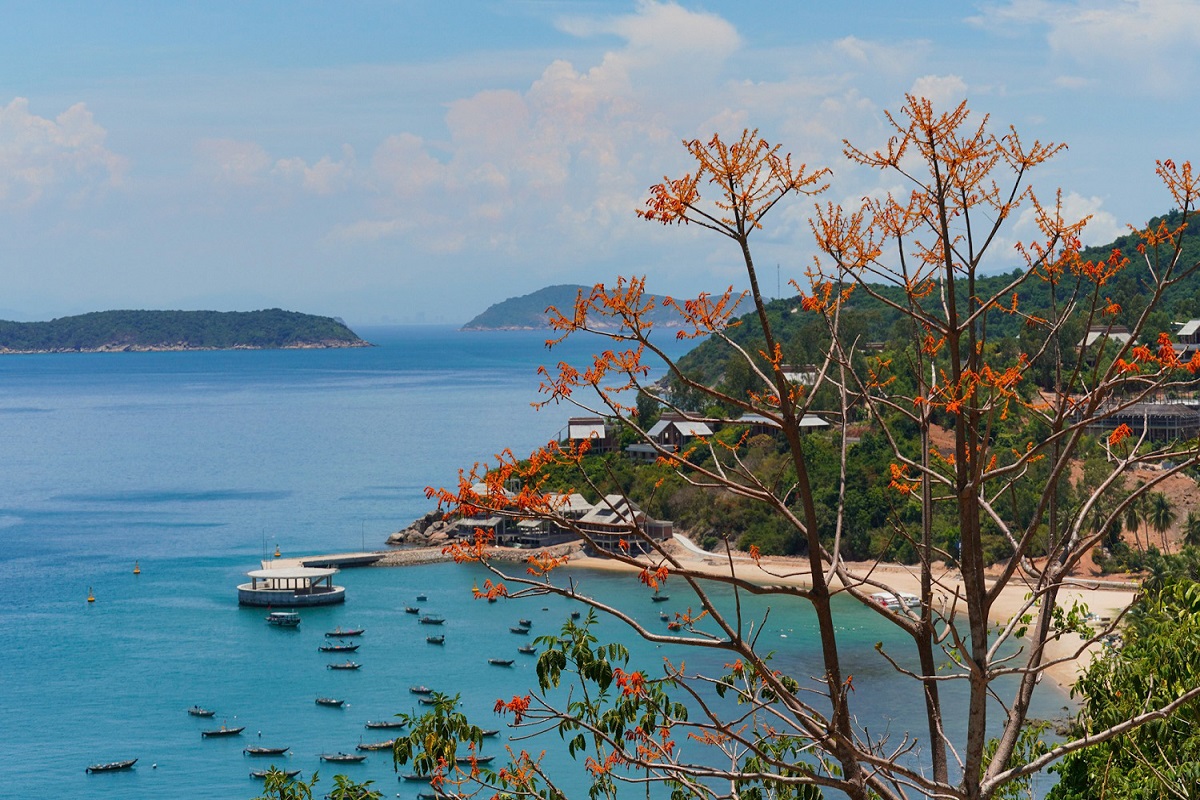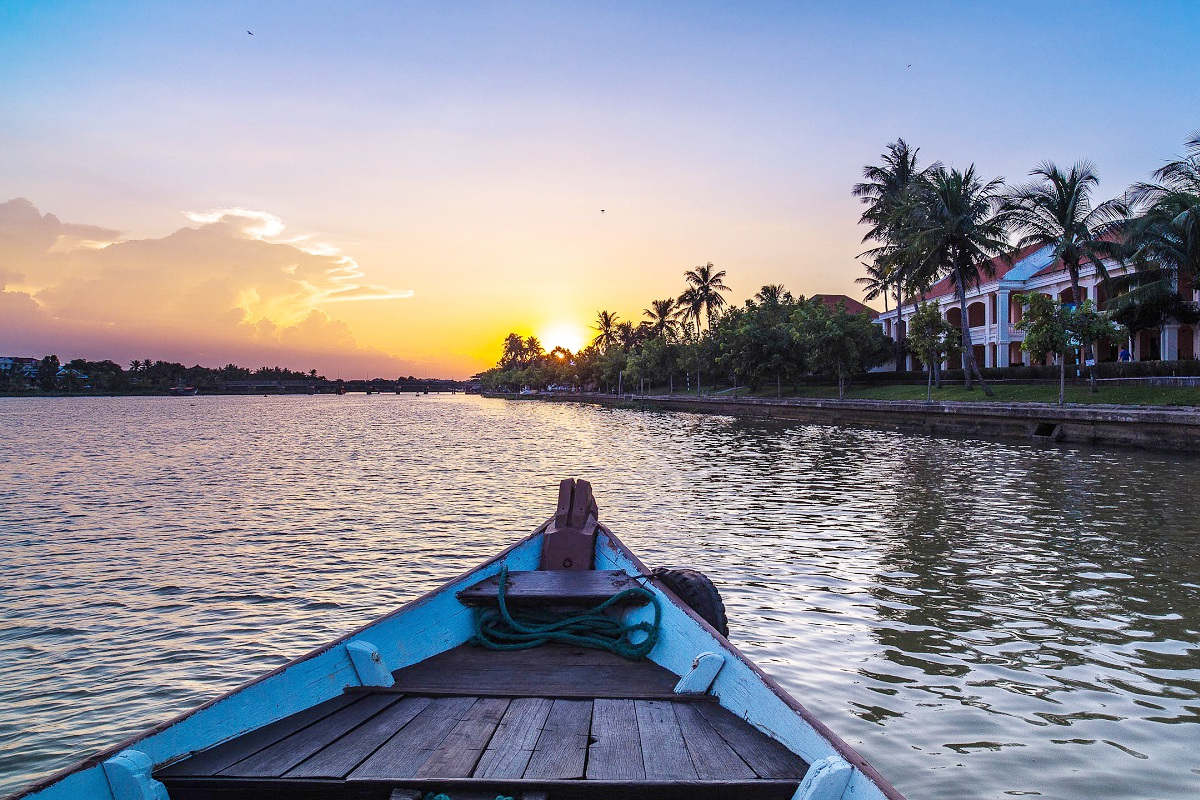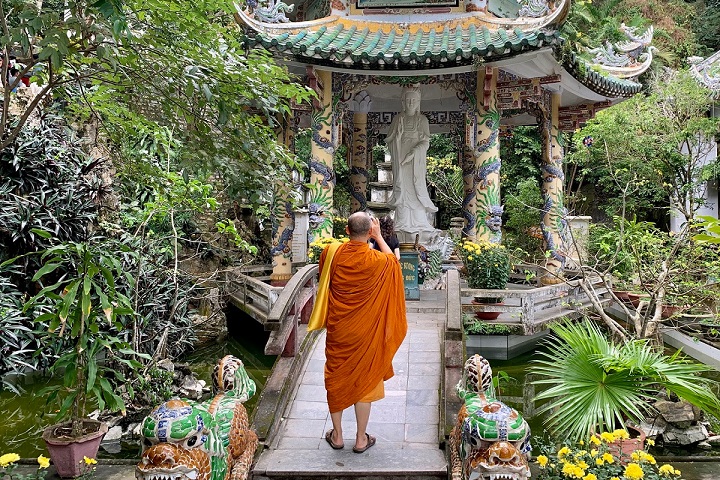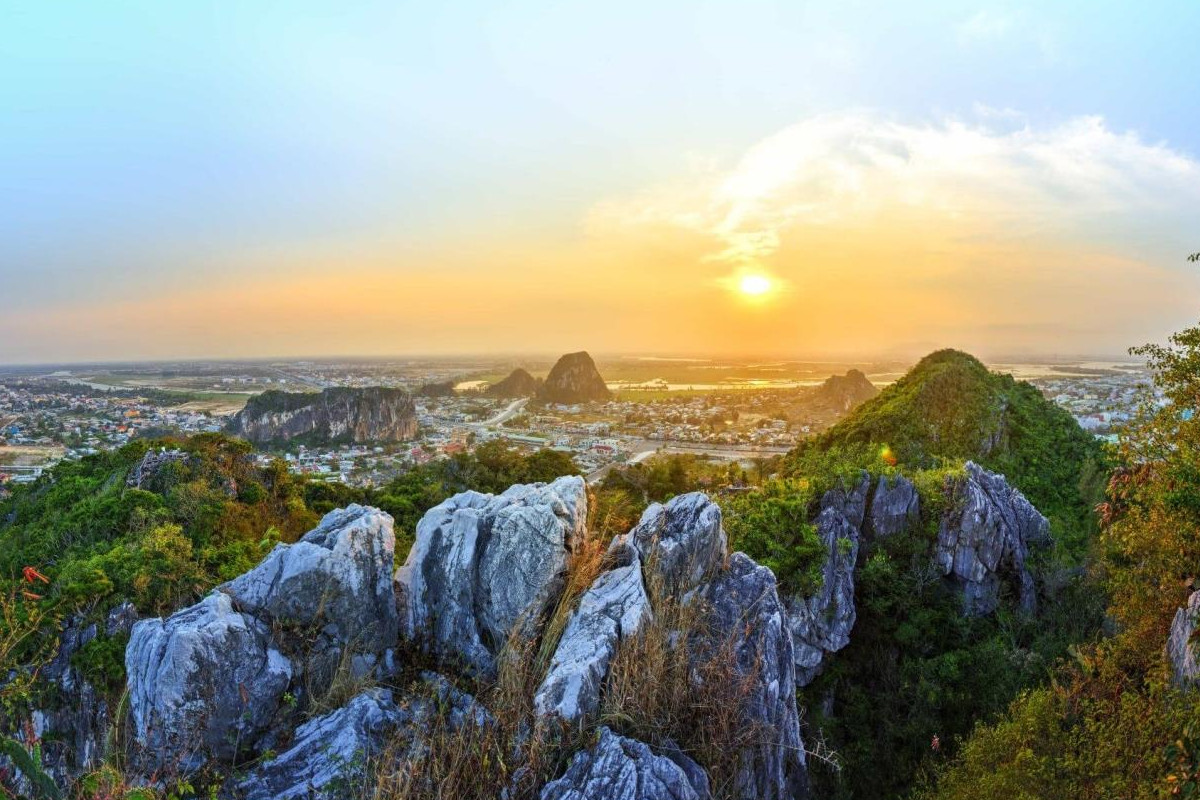Situated 30km south of Da Nang, Hoi An ancient town is one of the best attractions in Central Vietnam. It is titled as the prettiest town of the country and in recent times, attracts at least 6 million of tourists each year. This stunning historic place boasts of old traditional houses painted by an eye-popping yellow, decorated by lanterns and blooming flowers. It’s studded with religious buildings, busy markets and shops. Nearly all of the time during the day, the town is bicycle and pedestrian friendly.
After the sun disappears, thousands of lanterns light on, turning the quarters into very colorful and sparkling ones. Down the river, visitors love to get on lantern boats and drop candle lanterns to the water, making it also mesmerizing. The best night is in Hoi An lantern festival every month. Besides photo and shopping opportunities, there are plenty of places to eat out here to taste Vietnamese authentic flavors, from streets to five-star restaurants. Now, we outline a complete Hoi An old town Unesco world heritage guide, to tell travelers all highlights of it.
See also:
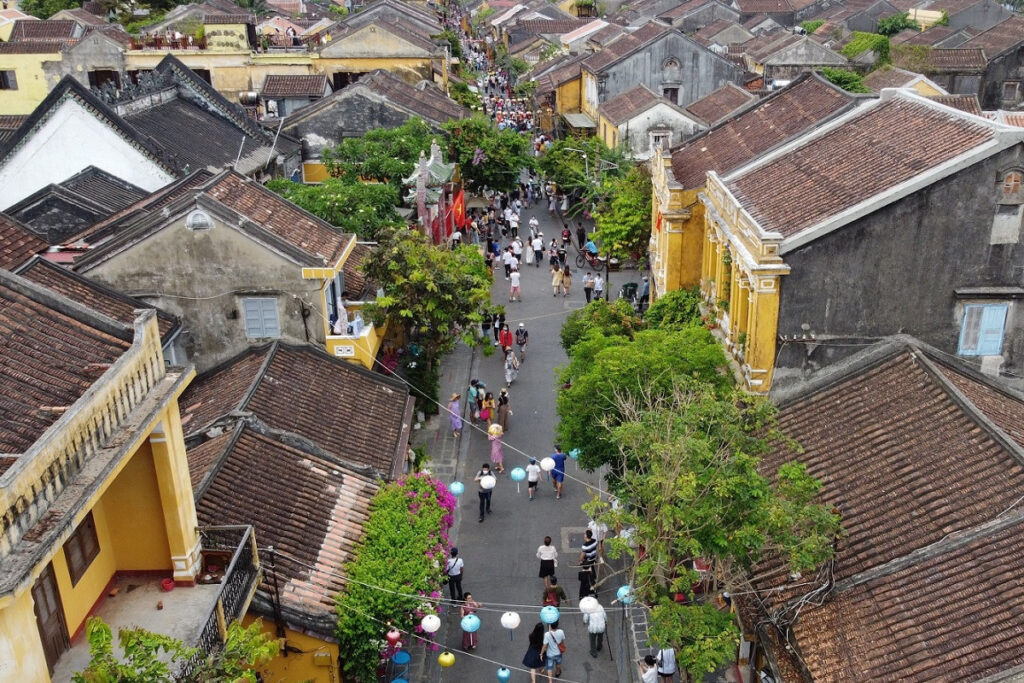
Table of content
- 1 Hoi An Ancient Town Introduction
- 2 Hoi An Ancient Town World Cultural Heritage
- 3 Hoi An Ancient Town Entrance Fee and Guide
- 4 How to Get to Hoi An Ancient Town
- 5 Getting around Hoi An Ancient Town
- 6 Best Time to Visit Hoi An Old Town
- 7 Hoi An Ancient Town History in Brief
- 8 Hoi An Ancient Town Attractions
- 9 What to Do in Hoi An Ancient Town?
- 10 Where to Eat in Hoi An Old Town?
- 11 Coffee Shops in Hoi An Old Town
- 12 Festival in Hoi An Old Town
- 13 Where to Stay in Hoi An Old Town?
- 14 Hoi An Old Town Map
- 15 Related Posts
- 16 Bach Ma National Park: Hiking, Trekking in Da Nang and Hoi An
- 17 Hoi An Wet Season: What to Do in Hoi An When It Rains?
- 18 Thanh Ha Terracotta Park
- 19 Vinwonders Nam Hoi An Theme Park (formerly Vinpearl Nam Hoi An)
- 20 Am Phu Cave (Hell Cave) – Things to Do in Da Nang
- 21 Hoi An or Hue: Which is Better?
- 22 The Official Hoi An Travel Guide (MUST READ)
- 23 The Hoi An Market (Hoi An Central Market) Complete Guide
- 24 Hoi An Memories Show: The Best of Hoi An Impression Theme Park
- 25 Hoi An Bridge: Famous Bridges in Hoi An
- 26 How to Get From Hoi An to My Son Sanctuary
- 27 Hoi An’s Chinese Assembly Halls and Chinese Temples
- 28 Hoi An Walking Tours: Heritage, Foods, Photography & Locals
- 29 Hoi An Self Guided Walking Tour – Hoi An On Your Own
- 30 How to Visit Golden Bridge Vietnam
- 31 Unique Experiences in Hoi An and Why?
- 32 An Bang Beach: A Guide to Hoi An’s Best Beach
- 33 Experiences in Hoi An: Get Insight Into Hoi An’s Local Culture
- 34 Things to Do in Ba Na Hills Besides Golden Bridge
- 35 Hoi An Nightlife: What to Do in Hoi An At Night?
- 36 Hoi An Countryside: Villages, Rice Fields & Tours
- 37 How to Get to Golden Bridge From Hoi An
- 38 Hoi An Entrance Fee: Old Town, Golden Bridge, My Son, More
- 39 Hoi An Airport: Everything You Need to Know
- 40 Hoi An Lantern Boat Ride on Hoai River
- 41 Hoi An Private Car and Driver
- 42 What to Do in Hoi An Ancient Town
- 43 Da Nang and Hoi An Itinerary for Visitors Staying Overnight in Hoi An
- 44 Hoi An 3 Day Itinerary: A Travel Plan for 3 Days in Hoi An
- 45 Hoi An Free Things to Do: Budget Travel in Hoi An Vietnam
- 46 Hoi An One Day Itinerary: A Travel Plan for One Day in Hoi An
- 47 Hoi An Half-Day Tours: Guide to Half Day Trips From Hoi An
- 48 Hoi An Day Tours: A Guide to Best Day Trips From Hoi An
- 49 Hoi An Beach: A Guide to All Beaches in Hoi An Vietnam
- 50 Hoi An Food Specialties
- 51 How to Get From Hoi An to Da Nang
- 52 Hoi An Cheap Things to Do: All Solo Travelers Need to Know
- 53 Hoi An Best Things To Do: Recommendations from Local Experts
- 54 Hoi An Things to Do: All What Can You Do in Hoi An Vietnam
- 55 Hoi An Things Not to Miss: A Guide to Must Do in Hoi An
- 56 Hoi An or Da Nang: Which is Better for First Time Visitor?
- 57 Hoi An Pottery Village: A Guide to Thanh Ha Pottery Village
- 58 Hoi An Ancient Town Tour
- 59 Hoi An Old Town Ticket: Price, Sellers, Included Sites, More
- 60 My Son Sanctuary Tour
- 61 Hoi An Lanterns: Festival, Making Class, Where to Buy, More
- 62 Hoi An Best Area to Stay: Guide to Where to Stay in Hoi An
- 63 Hoi An Weather by Month: Guide to Hoi An Monthly Weather
- 64 Hoi An River Cruise: Guide to The Best Boat Tour in Hoi An
- 65 Hoi An Old Town Boats: Guide to Boat Rides in Hoi An Town
- 66 Hoi An 2 Day Itinerary: Traveler Guide to 2 Days in Hoi An
- 67 Cham Island Hoi An
- 68 Hoi An Basket Boat Ride
- 69 Hoi An Coconut Village: A Guide to Cam Thanh Coconut Village
- 70 Hoi An Cham Temples: My Son Sanctuary & Quang Nam Temples
- 71 How to Get from Da Nang Airport to Hoi An
- 72 Da Nang to Hoi An: Best Da Nang Airport Transfer and More
- 73 Hoi An Tour Guide: How to Find a Private Tour Guide in Hoi An
- 74 Hoi An Ancient Town Attractions
- 75 Hoi An Old Town Map
- 76 Tra Que Vegetable Village
- 77 Guide to Hoi An Lantern Festival – Hoi An Full Moon Festival
- 78 Hoi An Night Market: A Thing to Do in Hoi An at Night
- 79 My Son Sanctuary Travel Guide
- 80 Hoi An Old Town Unesco World Heritage – Hoi An Travel Guide
- 81 Featured Tours and Experiences
- 81.0.1 Bach Ma National Park Tour from Hue
- 81.0.2 Bach Ma National Park Tour from Da Nang/Hoi An
- 81.0.3 Hoi An Sunrise Fish Market Tour
- 81.0.4 My Lai Massacre Tour
- 81.0.5 Golden Bridge/Ba Na Hills & Hoi An Tour
- 81.0.6 Hoi An Instagram Tour
- 81.0.7 Ky Anh Tunnel & Tam Thanh Mural Village Tour
- 81.0.8 Da Nang to Hue Motorbike Tour with Hai Van Pass & Easy Rider (1 Way)
- 81.0.9 Hue to Da Nang Motorbike Tour with Hai Van Pass & Easy Ride (1 Way)
- 81.0.10 Hue to Hoi An Motorbike Tour with Hai Van Pass & Easy Rider (1 Way)
- 81.0.11 Hoi An to Hue Motorbike Tour with Hai Van Pass & Easy Rider (1 Way)
- 81.0.12 Tra Que Vegetable Village Tour with Cooking Class
- 81.0.13 Ba Na Hills Half Day Tour from Hoi An
- 81.0.14 Marble Mountain & Hoi An Day Tour from Da Nang Port
- 81.0.15 Hue Day Tour from Chan May Port with Lunch
- 81.0.16 Marble Mountain & Hoi An Tour from Chan May Port
- 81.0.17 Ba Na Hills/Golden Bridge Tour from Da Nang Port
- 81.0.18 Ba Na Hills/Golden Bridge Tour from Chan May Port
- 81.0.19 Golden Bridge Private Tour with Ba Na Hills & Lunch
- 81.0.20 Ba Na Hills Afternoon Tour with Golden Hands Bridge
- 81.0.21 Ba Na Hills Private Tour with Golden Hands Bridge
- 81.0.22 Ba Na Hills Half Day Tour with Golden Bridge
- 81.0.23 Ba Na Hills Early Morning Tour to Beat the Crowds
- 81.0.24 Golden Bridge and Ba Na Hills Night Tour
- 81.0.25 Golden Hands Bridge Tour In Sunrise or Sunset (1/2 Day)
- 81.0.26 Cam Kim Island Bicycle Tour From Hoi An
- 81.0.27 Cham Island Tour From Hoi An (Group Tour)
- 81.0.28 Cham Island Tour From Da Nang (Group Tour)
- 81.0.29 Hoi An Vegetarian Food Tour
- 81.0.30 Hoi An Evening Walking Food Tour with Local Foodie
- 81.0.31 Private Hoi An Basket Boat Tour (Shuttle Bus, Bicycle, Bike)
- 81.0.32 Half-day Am Phu Cave Tour (Private)
- 81.0.33 Hoi An Countryside Tour by Electric Car or Bike
- 81.0.34 Da Nang Tour Package From Singapore
- 81.0.35 Hoi An Evening Tour From Da Nang with Lantern Boat Ride
- 81.0.36 Hoi An Walking Food Tour Through Laneways
- 81.0.37 My Son Sanctuary and Hoi An Old Town Tour
- 81.0.38 My Son Day Trip From Hoi An including Marble Mountains and Basket Boat
- 81.0.39 Half Day Hoi An City Tour With River Cruise
- 81.0.40 Son Tra Peninsula Tour with Marble Mountains (Private/Small Group)
- 81.0.41 Hue Day Trip From Hoi An with Hai Van Pass, River Cruise & Lunch
- 81.0.42 Hoi An Ancient Town and Countryside Tour (Bests of Hoi An Tour)
- 81.0.43 Hoi An Tour From Da Nang Airport (Private, Optional Lunch)
- 81.0.44 Hoi An Day Trip From Da Nang (Marble Mountains, Basket Boat, Old Town)
- 81.0.45 Da Nang City Tour From Airport (Private, Optional Lunch)
- 81.0.46 Hoi An City Tour with Lantern Class, Lantern Boat, Night Market & Local Food Sampling
- 81.0.47 Marble Mountains, Basket Boat Ride & Hoi An Old Town Walking Tour
- 81.0.48 Marble Mountains & Golden Bridge/Ba Na Hills Day Tour
- 81.0.49 Marble Mountains & Monkey Mountain Tour (Half-day, Private)
- 81.0.50 Private Golden Bridge Sunrise Tour (Half-day, Optional Lunch)
Hoi An Ancient Town Introduction
Located in Vietnam’s central province Quang Nam, Hoi An ancient town is a well-preserved historic trading town dating from the 15th to 19th century. Throughout 400 years, this international hub of commerce draws merchants from different parts of the country and all the world over. The businessmen come here to trade spices, high-quality silks, handcrafted objects, minerals and more.
Besides Vietnamese, Japanese, Chinese and Europeans settling down in town also, many of them get married with locals. Each leaves their own tangible and intangible traces, now visible around the quarters. In 1999, Hoi An ancient town was recognized by Unesco as a world cultural heritage because of its remarkably intact state. Travelers love to roam around, enjoy a lively atmosphere, sightsee age-old remains, photograph nice pictures, taste delicious foods, get lantern boats, tailoring and go shopping.
Within an area of 30 hectares, Hoi An ancient town now features lantern-lit streets running parallel Thu Bon river and the others set at right angles. It houses over 1,300 old houses with yellow walls, timber furniture and tiled roof, ornate temples, vibrant markets and featured museums. While many constructions have been retained for sightseeing, many are converted into tailors, restaurants, café, art galleries, bars, souvenir shops and massage parlors.
Hoi An ancient town is bicycle and pedestrian-friendly. In nearly all daytime and evening, its streets are free from moving motorcycles and cars like the outside.
Read also: Hue Imperial City Traveler Guide

Hoi An Ancient Town World Cultural Heritage
Unesco Designated Boundaries
Hoi An ancient town has been recognized as a Unesco world heritage site since 1999, with two universal outstanding values met. This prime title requires clear boundaries that are designated to include the best-preserved parts of it. Its total area is 30 hectares, surrounded by Phan Chau Trinh St to the north, Thu Bon river to the south, Hoang Dieu St to the east and Cao Hong Lanh St to the west. Hours for non-motorized vehicles are regulated daily to reduce traffic followed by noise, air pollution and lack of safety for walkers.
Within the boundaries, well-protected places such as Japanese covered bridge, Chinese assembly halls, old houses and family temples are placed in the highest level of conservation. Several houses are converted into themed museums, about history and cultures. All provide a nice architecture to visit and take photos, interesting history to listen to and informative exhibitions. By that, a ticket is required there, but included in Hoi An ancient town entrance fee.
Hoi An Ancient Town Pedestrian Times (Walking Hours)
Aiming to be friendly for pedestrians and cyclists as much as local authorities can do, pedestrian hours are regulated in Hoi An ancient town, to ban motorized-vehicles. This is for both locals and tourists. Everyday, that is from 9 to 11 a.m and 3 to 10 p.m, and in the wet season, it begins from 9:30 in the morning. If riding a motorcycle to the town, travelers need to park somewhere outside of the Unesco designated area and then walk. Remember location of the place and to ask about what time people there stop the service, especially in the evening. In common, should return to take the bike around 10 p.m. The rate is often 5,000 VND.
If like to stroll in the Night market and visit late night bars near it, at the end of the walking itinerary, should leave your vehicle close by. Taxi riders are many outside of the pedestrian zone’s boundaries, to get a ride to go to the next stunning place or return to the hotel. They don’t mind serving a drive to Da Nang.
Read also: Hoi An Walking Tours: Heritage, Foods, Photography and Local
Hoi An Ancient Town Entrance Fee and Guide
Price and Inclusions
Hoi An ancient town entrance fee is 150.000 VND for adults and teenagers above 16-years-old, and free for childrens under 16-years-old. This covers entries of the whole Unesco-designated area and 5 sightseeing places and traditional shows. If would like to see more, travelers will have to buy another ticket. It’s not necessary to reserve Hoi An entrance fee in advance, so just come to ticket booths standing by streets leading to the town. List of ticketed sites and where to watch the performances is provided as follows below. To easier find the nearest counter to you, see our Hoi An Old Town Map.
See the list of all included sites in our article to Hoi An Old Town Ticket
Where to Buy Hoi An Ancient Town Entrance Ticket?
Ticket booths are always close to roads leading into Hoi An ancient town, from 7 a.m to 8 p.m daily. Some of them open to 9 p.m, especially during peak season and lantern festival day because of many tourists at that time. Staff there can understand English to answer questions from travelers and give recommendations. Cash in Vietnam dong is accepted only but they will help to exchange other currencies if not enough. Hoi An ancient town map is available to take for free, showing ticket-required places and highlights to eat out and drink. It’s available in most popular languages around the world.
See the list of places to buy tickets in Hoi An Old Town Ticket
Validity
According to what is shown in the ticket, Hoi An ancient town entrance fee validity is within the day visitors purchase only. To optimize time, should start the visit in the morning and if come in the afternoon, time well to make full use of your chance to sightsee. Nearly all of the places close their doors at 5 p.m but some famous ones at 6 p.m (may be Tan Ky house or Fukian assembly hall). It’s possible to walk in the Japanese bridge or Quan Cong temple (in front of Hoi An market) in the evening. However, in fact, the holders can use the ticket the whole time they stay over in the city. This is an open policy for international tourists who travel without rush. If forget to bring the ticket, travelers can show their photos in ticketed places as a proof to roam around the town (when someone asks). But, it’s impossible to enter any others of the kind.
Hoi An Ancient Town Guide
On-site guide is available to book in any Hoi An old town ticket counters. He or she is well-trained by the official management board and the Unesco, to provide the most correct and detailed information to visitors. In the tour, historical sites and museums are the focus where everything needed to know about them is told. Moreover, the guide also recommends handicraft shops to better understand local crafts and products, tailors, restaurants, coffee shops or street foods to try. English and Vietnamese are two most popular languages but if require another rarer one, should announce it in advance (especially in high seasons).
Text us in whatsapp number +84968009827 if need a private tour guide in Hoi An.
How to Get to Hoi An Ancient Town
Where is Hoi An Ancient Town?
Hoi An is an old town down the Thu Bon river, about 30km from Da Nang where major and the busiest transportation hubs of Central Vietnam are located. There are airport, harbor, railway and bus stations. If travel it by aircraft, train or cruise, people will arrive at Da Nang first and then take another kind of vehicle to transfer to Hoi An. Buses and couches can go direct to Hoi An bus station or their company offices, offering reasonably-priced tickets. After arrival, a short drive or walk to the Unesco site is required. Some 80km to the south, a couple of flights land at Chu Lai airport, giving another choice to travelers to get by air.
From Anywhere in Hoi An
Ancient town is the core of Hoi An, therefore it’s convenient to get to it from anywhere. If stay over in “the center”, walking is the best choice because the distance is short and walkers can come to every corner they like. Bicycles are the most picked vehicle to ride to Hoi An ancient town, because it’s available for free in most hotels and possible to get around in most hours of the day. Only a few minutes from the downtown, 15 minutes from An Bang beach or Cam Chau and a little more if travelers stay in other areas. Traffic is not crazy but busy in rush hours, so just be confident in your riding skills.
Taxi is another vehicle quick to get and not expensive. If don’t have a Vietnam sim card, come to reception and the staff can definitely help. The rate is often not more than 20,000 VND per kilometer. Outside of walking streets, it is easy to find a cabby to go to another place or return the room. If have booked a motorcycle for a few days, make full use of it and take it. During pedestrian times, can’t ride it around the town and need to leave somewhere (remember the location and keep the number card carefully). Parking fee there is 5,000 VND.
Get From Da Nang to Hoi An Ancient Town
Hoi An ancient town is situated 30km south of Da Nang. It’s a favorite place to visit and enjoy the weekend for Da Nang residents, and riding a motorcycle is their choice. The drive is without difficulties, no matter which route the riders like, the Coast road Truong Sa St or inner Le Van Hien St. Should start in the morning to have much time to sightsee them. If don’t stop anywhere too long, it takes about 1 hour for a motorbike ride. Due to convenience and many seats, taxis and private cars are the next popular vehicles. An affordably-priced transfer is from 160,000 to 250,000 VND one way for a private car, and more expensive to a four-seat taxi.
Read also: Da Nang Airport to Hoi An
Da Nang to Hoi An Bus
Public buses charge the lowest cost to get from Da Nang to Hoi An ancient town. Currently, there is only one bus available, numbered #1 and ticket price is 20,000 VND. Its operational hours are from 5:30 a.m to 5:50 p.m everyday, with a total duration of 1,5hrs and a frequency of 30mins. Travelers can come to the terminal Da Nang Bus Station in Ton Duc Thang St or pick-up points around the downtown (for example, Ong Ich Khiem, Nui Thanh or Le Van Hien St). Luggages may be surcharged about 10,000 VND if much, really depending on the attendant. The last stop is Hoi An Bus Station in Le Hong Phong St, 1km to Hoi An ancient town. So after leaving the bus, travelers just need a short walk or ride by taxi or xe om (motorbike taxi) to visit the Unesco site.
In the halfway of Da Nang to Hoi An bus route, plenty of travelers choose to visit the Marble mountains, a group of striking five marble and limestone hills. The oldest Buddhist temples are located there. Reasons are convenience and that the attraction is a must see. After getting off, just walk as the distance from drop-off point to entrances/ticket counters is short.
Read also: Da Nang to Hoi An
Getting around Hoi An Ancient Town
Walking
This is the best way to tour around, visit stunning places and explore hidden gems inside Hoi An Old town. While walking, travelers can marvel closer at historical buildings, colorful houses and sparkling lantern lights at night. In addition, also have a chance to see the daily life of local inhabitants, taste yummy street foods, visit tailors and discover little-known places where you never know if you don’t walk. The best time is in the morning when crowds of tourists haven’t come yet, and late afternoon onwards when the temperature becomes cooler. After it rains during the wet season, it’s more pleasant as well to stroll on streets. Full moon festival is another perfect time, in which walkers can admire marvelous scenes from countless lanterns.
Bicycle
Bicycles are normally available for free in Hoi An’s hotels, so it becomes the best vehicle choice of many trippers to get to and ride around the Old town. For those who stay somewhere without any bicycles, it’s possible to hire one right there at a low rate. All roads are flat, supporting two-way traffic but in crowded hours (especially late afternoon or lantern festival), the rider needs to be more patient than usual, to move through crowds of pedestrians. Parking on the pavement is allowed in the Unesco heritage area without a fee, but highly recommended to leave it in the venue you’re in for better safety. Unlike motorcycles, bicycles can be accessed anytime of the day and any corners. Should prepare or ask for a lock to avoid loss.
Bicycle Rental in Hoi An Ancient Town
If a bicycle is not available in your hotel or you just have a quick visit, it’s easy to rent one to get around Hoi An old quarter. Near the boundaries of the Unesco world heritage zone, like Phan Chu Trinh, Hoang Dieu and Nguyen Phuc Chu streets, bicycles for hire are many to select. Front basket is often attached. Price is really cheap, about 20,000 VND for one day. Should remember the exact location of the rental place and ask what time it closes to return in time. Within the town, there are various choices too, both on an hourly and daily basis.
Cyclo (Xich Lo)
Many travelers love to get a cyclo ride leisurely around Hoi An Old town, especially first timers. Not only an experience with a Vietnamese signature vehicle, the passengers also save time to move around if they travel without a bicycle or motorcycle. There are two ways to find a cyclo rider: raising your hands at the one you meet or coming to “terminals” (the Folklore Museum or Cantonese Assembly Hall). Most licensed riders wear a blue shirt as a uniform. Prices are different between two, the first type charges more expensive because they work for themselves, but their ride is longer. These free riders request to pay from 150,000 to 250,000 VND for one person, in about 15 minutes. One more person charges a small additional price. By contrast, terminal riders are staff managed by a boss who receives bookings and announces to them about their duty ride later. So, the rates he provides are often lower, to be suitable for a group of tourists. No matter which is your choice, Hoi An old town’s cyclo ride often includes Chinese temples (as a stop to see), lantern lit streets and some other historic landmarks.
Motorcycle
In the early morning and the midday, motorcycles are allowed to move around the Old town. This policy aims to serve the convenience for life of local inhabitants at the times when they go to work, return home for lunch and come to the office again then. Moreover, its streets have lower traffic than others because of the high temperature, so not much worries about visitor safety. If plan to sightsee or eat out somewhere during these common hours, it’s possible to ride the bike directly to get there. Should time well to leave the pedestrian zone before it can’t move anymore. If stay later, have to walk with it and remember to search the nearest spot where the rider is accepted to drive. Simpler, asking staff in the place you’re in.
Best Time to Visit Hoi An Old Town
The best time to visit Hoi An ancient town is from January to July when the rainfall is low and it’s free from typhoons. It is ideal to get to and wander around streets, sightsee historic buildings, photograph nice pictures and taste the most diverse street foods ever. Additionally, also to participate in outdoor activities and events, such as Hoi An full moon festival. However, the temperature in this period is usually high and reaches the peak from April to June. The strong heat definitely makes travelers quickly sweaty, tired and may harm the skin. It’s very necessary to bring sun cream, a hat, cap or umbrella and lots of water to drink during the visit. Lightweight clothings is good to get on, for a more pleasant feeling. Around February and April to the end of May, streets are full of Vietnamese tourists, making nearly all of the places overbooked and the price higher than usual.
On the other hand, it’s rainy and stormy at many times from August to December (known as the wet season). Floods often occur in the Old town, caused by pouring rains and overflowing Thu Bon river. Many attractions, shopping and dining places have to be closed, making the options to explore limited. The most interesting activity is being on a boat and cruising on inundated streets (like Venice) to see things. A special experience is that not all tourists have the chance to know. Anyway, should check the weather forecast in advance to avoid or arrange travel plans better.
Just about the day, the morning and late afternoon onwards are the best times to visit Hoi An old town, because it’s cooler and quieter. Every month, the lantern festival is held at night, characterized by gorgeous scenery from so many lighting lanterns. It’s another perfect time to walk around and admire the beauty of the town.
Read also: Hoi An Monthly Weather

Hoi An Ancient Town History in Brief
Earliest remains about human settlement in Hoi An are belonged to Sa Huynh Culture which flourished along the coast from 1000 BC to 200 AD. It’s widely known for burial practice in pottery jars. The later inhabitants were the Chams, particularly the Coconut clan. In 2nd century, this clan was unified with the Areca clan to the south, and Champa Kingdom was formed. The capital city was placed in Tra Kieu today, 20 km away from Hoi An and My Son Sanctuary. At that time, Hoi An was named “Champapura” (meaning the City of the Chams) and a major trading town of the Hindu-followed state. Persians, Romans, Chinese, and other people visited here to exchange. In 1306, this area was handed over to Viet people in the north after marriage between princess Huyen Tran and reigning Champa king. It’s a wedding present.
The most prosperous period of Hoi An was from 15th to 19th centuries. During that time, it’s known as a thriving international trade port in South-east Asia, on the Maritime Silk Road. Merchants liked to moor here for business, because of abundant and high-quality sources of spices, silk, and handicraft products. Japanese first settled in this small town and then, Chinese and lastly Europeans. Each group of people left influences on local architecture and culture. Due to persecution, Christian missionaries hide here and seek ways to evangelize. They invented a new language to communicate with locals, and that is what Vietnamese currently use to write (called chu quoc ngu). In 19th century, commerce in Hoi An started to decline, as a result of policies from the emperors and estuary reclamation. After that, it became a backwater town until the Unesco title in 1999 which made a tourism boom.

Hoi An Ancient Town Attractions
Main article: Hoi An Ancient Town Attractions
The Japanese Covered Bridge
Spanning a small canal, this ancient building is Hoi An’s emblem. It’s constructed by Japanese people in 17th century, making its name. Later, Chinese rebuilt it and added a Taoist temple behind. Since then, local people have called “the Pagoda bridge”. See more details in https://centralvietnamguide.com/japanese-covered-bridge/.
Old Houses in Hoi An
Hoi An preserves more than 1,000 buildings, including many old houses. While visiting around, sightseers will know better local lifestyle and family culture. By Hoi An old town ticket, it’s possible to enter Tan Ky house, Duc An house, Quan Thang house.
Chinese Assembly Halls
There are 5 Chinese communities in town, and by that, visitor will see five assembly halls. That ones belong to Fujian, Hainan, Chaozhou, Cantonese people.
Hoi An Central Market
Temples and Pagodas
Museums
Free Attractions in Hoi An Old Town
Sunday in Hoi An (Hoi An Vibes Only)
Location: 76 Tran Phu St-Opening hours: 7 a.m to 8 p.m
This souvenir shop is one of the best instagrammable spots in Hoi An old town. It doesn’t mind welcoming travelers to come and take pictures with its pink wall of “Hoi An vibes only” words and cactus, without any fee. Its location is between the Trading ceramic museum and the All-community assembly hall.
Ba Mu Temple Gate Hoi An
Location: 76 Tran Phu St-Opening hours: 7 a.m to 8 p.m
Ba Mu is a Chinese temple established in 1626, for worship of the Deity of Medicine, Mazu Sea Goddess, the Twelves Midwives, 36 generals and moved to its current location then. Historians say there are no reliable documents to tell us when. It had been one of the most monumental constructions in the entire Hoi An town, before partially falling by wars and time. Now, only its main gate still stands on the ground and has been reconstructed recently. Thanks to the
grand architecture behind a lotus pond, this soon became widely-known by instagrammers. Nice photos can be taken in the evening as well, not only day hours.
Precious Heritage by Réhahn
Location: 26 Phan Boi Chau St-Opening hours: 8 a.m to 8 p.m
This is the largest exhibition of art photos taken by talented Réhahn, a French photographer living in Hoi An with love. There are around 200 impressive pictures and 62 featured traditional costumes of all groups of people in the country it accommodates. Story about the challenging journey of the photographer to seek the right village and right person is narrated on each wooden information board. Some communities are very small and many costumes are the last to be made, making his works priceless and efforts extremely worthappreciating. Folk music is always on during the visit. Visitors also can admire the Réhahn photography albums while sipping a cup of coffee from the barista here. The location is not in walking quarters, so feel free to ride the bike to this Hoi An’s best art gallery.
Ba Le Well
Built by Champa residents by their own intricate techniques, this well was renovated several times before completely like today in the early 20th century. The last renovation is sponsored by Miss Ba Le, therefore people call it the same to say thanks. It still produces fresh and clean water over hundreds of years. Its water becomes a must-have ingredient in making Hoi An signature noodle dish Cao lau because of the high qualities. There are some locals who earn money for living by carrying water to restaurants. A household nearby offers to exchange a piece of “sightseeing place” in Hoi An old town ticket, for a bowl of black sesame soup. That’s named as che me den, can’t be found anywhere else.
What to Do in Hoi An Ancient Town?
Get Custom Made Clothes in Hoi An Tailors
The ancient town is home of the best tailors in Hoi An and hundreds of others. Thanks to professional and quick service, variety of choices (fabric, item, style and price) and being highly-met personal specifications, lots of travelers aim to make a customized garment when traveling to Hoi An. Suit, shirt, pants, jacket, dress and all other items travelers show in their phone, all are easy to make for local tailors. It takes around 24hrs to come to first fitting and shortly then to the last one. Tailors also don’t mind visiting the hotel room for fittings (if accepted) to serve a convenience to their fashion lovers. But in common, it’s needed to visit the shop. Shipping to home anywhere in the world is the next advantage, available at inexpensive rates.
Many local women try to talk with travelers and recommend their known tailors. Be aware, the price may be more
expensive than common, because the shop has to pay commission.
Cooking Class
Travelers can find stunning hands-on Vietnamese cooking classes in the Old town of Hoi An, to get insight into local cuisine. In which, learners will deepen their understanding about different ingredients, recipes and taste what they make in the end. All are guided by an experienced English-speaking chef. Some experiences include a visit to a traditional fresh market to allow learners to know the shopping culture of locals (like bargaining). It’s possible to search and book a class with an early fish market in its program, but not too many choices to pick. Not only in the daytime, Hoi An cooking classes also are of evening class and vegan menu.
Read also: Cooking classes in Hoi An
Hoi An Night Market
After the sun disappears, Hoi An night market becomes the next tourist draw and a must-visit attraction at night in town. It includes over 100 stalls arranged along Nguyen Hoang St, from the crossroad of Nguyen Phuc Chu St until the end. A stroll around it provides opportunities to take beautiful pictures with colorful lanterns, try delicious foods and nice drinks, buy cheap souvenirs and simply watch the world go by. Instagrammers love to come here for photos and foodies come frequently to savor some amongst a variety of dishes sold. Hoi An night market food option is varied, from street bites, local specialties, fruits, barbecues to international and western snacks. Closing time is around 10:30.
Read also: Hoi An Night Market
Lantern Boat Ride
Getting a lantern boat ride is one of the best activities at night in Hoi An ancient town. It often durates from a few minutes to a half of an hour, depending on traveler requirements. While being on board, the scene of Hoi An lanterns at its most sparkling level, many photo opportunities and cool air are provided. The rate is not expensive, 20,000 to 50,000 VND per person and includes a candle lantern to drop down the water. Vietnamese do that to pray in Buddhist festivals, for themselves and beloved persons. Along the quay (Bach Dang St) and near the Japanese bridge, there’re many boat owners invited to cruise the river with them, but with different prices.
The best time to get a lantern boat ride is when Hoi An old town’s most crowded. Hundreds of lighting candle lanterns floating on the river and colorful lanterns in boats at that time, just create an epic and amazing scene. It becomes content for many of the most iconic pictures about Hoi An.
Read also: Hoi An Old Town Boats
Try Local Foods
Tasting scrumptious local street dishes and food specialties around Hoi An ancient town is a favorite of many tourists. On the pavement, it’s possible to seek banh beo (water fern cakes served with fish sauce), cao lau and mi quang noodles, banh mi sandwich, sweet soup, tofu, mango cake, crispy snacks, dumplings and more. In the late afternoon and evening, there are definitely the choices. Open-air grills are what pedestrians often see at that time and their owners sell banh uot cuon thit nuong. The dish is grilled pork wrapped with rice paper, raw vegetables and eaten with fully-flavored peanut sauce. People will sit on low stools, roll and enjoy this Hoi An cuisine highlight.
The Central market and Night market are foodie paradises in town, catering to a variety of eats (prepared in authentic recipes) with a reasonable price. Seatings are higher in the first place. If prefer a venue to enjoy the tasty flavors of Hoi An local food, there are plenty of choices.
Read also: Hoi An Food Specialties
Hoi An Lune Center for the Performing Arts
First high-quality cultural show of Hoi An lune center has arrived in Hoi An old town since 2018, after gaining many international rewards and success in the south. The only available performance now is “A O” which depicts Vietnamese culture from the countryside to the city, on the basis of contemporary art. Sound of 17 different musical instruments is used during this Hoi An’s activity at night.
Read also: Hoi An’s Cultural Shows
Handicraft Workshops
As a trading town, Hoi An houses traditional handicraft villages and plenty of artisans, to produce high-quality objects to export. Because of great passion, some expertly-skilled artists open their own workshops to share knowledge, techniques and skills for those who want to know. Their classes are absolutely hands-on experiences and fun. These are highlights:
-Lantern making: In the west of the Ancient town.
-Mask making: The Timming Mask Hoi An provides 2 hrs-course in which sir Phong Bui artisan instructs all 4 stages of mask making. Kids can paint the masks by colors they like, at a cheaper rate. Opening hours are from 9 a.m to 7 p.m everyday.
-Bamboo root carving: two guys Phuong and Do will guide visitors to create sculptures from bamboo roots, such as Buddha or old man statues. The traditional craft is available only in their workshop at 26 Bach Dang St (near the markets).
-Reaching Out Teahouse’s workshops: include tea mediation in the morning (9 to 10) and Vietnamese traditional waffles making in the afternoon (3 to 4:30). The first requires ages above 16 and the second is all ages. Price is 20 USD and 15 to 20 USD respectively.
Where to Eat in Hoi An Old Town?
Street Food Stalls
Street foods in Hoi An old quarter are in abundance, have delicious taste and are sold with a reasonable price. Trying them is one of the best ways to know better local culinary culture and is always recommended by travel experts as a top thing to do. Food tours introduce them in their program and they become an irreplaceable part. Surroundings of the Central market and Night market are two sanctuaries to seek and savor, the foodies say. There is a diversity of selections there, all sold at a reasonable price. However, the first mecca has seating and menu with clearly-shown rates.
Read also: Street Foods in Hoi An
Local Food Restaurants
Hoi An is a food capital in the country, famous for its rich culinary culture. Abundant source of fresh ingredients and lengthy cultural exchange between different cuisines support for that. List of local dishes and specialties is long and of course, a huge choice of places to taste them followed by. Visit Miss Ly Café, Hi Restaurant or Red Gecko Restaurant, travelers may find more than one option to explore the dishes never tried before.
Read also: Hoi An Food Specialties
Vietnamese Restaurants
Featuring a cozy atmosphere, Vietnamese restaurants in Hoi An old town are many to choose from and cater a menu with varied national and local dishes. In addition to Hoi An food specialties, highlights from other regions around Vietnam are also introduced.
These are top Vietnamese restaurants: (1) Lantern Town Restaurant at 49 Nguyen Thai Hoc St, (2) Pho Xua at 35 Phan Chu Trinh, (3) Secret Garden at 132/2 Tran Phu St, (4) Nu Eatery at 10A Nguyen Thi Minh Khai St, (5) Little Faifoo Restaurant at 66 Nguyen Thai Hoc St, (6) Morning Glory Original at 106 Nguyen Thai Hoc St, (7) Vy’s Market Restaurant at 3 Nguyen Hoang St, (8) Com Linh at 42 Phan Chu Trinh.
International Restaurants
Hoi An town has been a melting pot where different groups of people meet and exchange their culinary culture and foods. Not only between Vietnamese communities, but also other Asians, Europeans, Americans and Australians. Thanks to that, travelers have a variety of choices to savor many dishes from all parts of the world, just in a small area. Besides the owners, lots of foreign chefs live and work in numerous kitchens, to make hometown foods to serve
tourists. Of course, nobody else understands home flavors as clearly as them. These are highlights sorted by their
own type:
-The best Italian restaurant: Goodmorning Vietnam
-The best Indian restaurants: Baba’s Kitchen and Ganesh
-The best Greek restaurant: MIX Restaurant
-The best Thai restaurant: Thai Kitchen (Eat Thai – Hoi An)
-The best Japanese restaurant: Samurai Kitchen, Little Faifoo
-The best American restaurant: Burger Craft, Chef Burger, Hoi An Burgers Plus
-The best French restaurants: What Else Coffee, Le Cabanon Hoi An, Aubergine49 Restaurant, Green Chilli
Restaurant&Bar
-The best Mexican restaurant: Hola Taco.

Coffee Shops in Hoi An Old Town
See details in Hoi An’s Best Coffee Shops
There are so many coffee shops in Hoi An Old Town, to stop, cool down and go for caffeine on a walking tour around. Most of them are in vintage old houses, serve both Vietnamese traditional and western coffees made from local and imported beans. Local beans are sourced from the Central highlands, Vietnam’s largest cultivation area. In some venues, fresh and organic beans are roasted by in-house baristas, to keep the quality in the highest standards. Decorations, gardens and views are other attractions of the others. If don’t like to sit and watch flocks of pedestrians on the streets, travellers can access small and tranquil lanes to find their own hidden gem to escape the hustle and bustle for a while.
Festival in Hoi An Old Town
Read also: Hoi An Old Town Festivals
Hoi An Lantern Festival (or Hoi An Full Moon Festival)
Hoi An lantern festival takes place on the 14th day of every single lunar month in Vietnamese traditional calendar. In which, travelers can expect lantern-filled streets and waterways, in a variety of color, size, shape and location. According to recommendations from the local authority, the lanterns are lit by candle, just like in the past and venues should turn off their electric lamps to save electricity. Not just to see and take photos, folk games, Bai choi performances, crafts and classes to teach children traditional songs are also visible. Games often require a small fee to players (breaking the clay pot while being blindfolded for example). As it is the full moon day, this Hoi An’s celebration is also known as the Full moon festival. Locals say it originates from Buddhism culture.
Read also: Hoi An Latern Festival
Mid-Autumn Festival
Hoi An mid-autumn festival is a yearly celebration held on the 15th day of the eighth lunar month (the largest full moon). In this, local people make special cakes (banh trung thu) and buy fruits to prepare mam ngu qua (a tray of five kinds of fruit) for the ceremony. For childrens, they have candle lanterns as a gift. It aims to memorize ancestors and promote family reunions. In the street, lion and dragon dancers perform exciting dances, accompanied by loud drum sounds. Not just the night before the main festival day, travelers can expect to watch the
dances during the week before. The Mid-autumn festival in 2022 is at 10th September,
29th September, 17th September 2024 and 6th October 2025.
Where to Stay in Hoi An Old Town?
Vinh Hung Heritage Hotel
Location: 143 Tran Phu St-Contacts: telephone number (+84) 2353920575, email
(vinhhung2@vinhhunghotels.com.vn), webpage (vinhungheritagehotel.com),
In the heart of Hoi An old town, this hotel is an ancient house owned by a Chinese merchant formerly. In 1994, a new Vietnamese owner used it to provide rooms for tourists to stay over. Thanks to an elegant and classy architecture, it has welcomed many politicians and embassies all over the world during its lifetime. Now, there are four suites and two heritage options available to book here. That includes 2 on the ground floor (one twin, one double) and the
rest on the first floor (one twin, three doubles). In particular, heritage suites have balconies towards the street, making them become more booked. Breakfast is served from 6 to 9 a.m in the lobby. If book direct, benefits given are more, for example daily boat trip, 20-mins massage or having dinner with staff.
Because of heritage protection law, facilities here are limited but the guests have free use of the swimming pool and complimentary cuisine experience in Vinh Hung Riverside Resort&Spa, sister hotel.

If you are looking for a guide who is fluent in English and knowledgeable, text us in whatsapp number +84968009827.
Hoi An Old Town Map
Related Posts
Bach Ma National Park: Hiking, Trekking in Da Nang and Hoi An
Two best places for trekking and hiking in and near Da Nang are Son Tra mountain (peninsula) and Bach Ma national park. Which one is better is actually personal because these
Hoi An Wet Season: What to Do in Hoi An When It Rains?
No beach, no pool, no outdoor adventures? What to do in Hoi An when it rains? This is a very popular question from travelers who come to Vietnam in the
Thanh Ha Terracotta Park
Between 15th and 19th centuries, Hoi An was one of major stopovers for sailing merchants to trade in Southeast Asia. Meanwhile, craftspeople in its Thanh Ha village produce high-quality pottery
Vinwonders Nam Hoi An Theme Park (formerly Vinpearl Nam Hoi An)
In addition to historical and cultural attractions, nowadays Hoi An also has a couple of amusement parks to entertain. Definitely, they’re ideal places for families with children and groups of
Am Phu Cave (Hell Cave) – Things to Do in Da Nang
Although in the Marble mountains – the most visited attraction in Da Nang, travelers often miss Am Phu cave. One of reasons is that it’s mentioned much online and not
Hoi An or Hue: Which is Better?
Both Hoi An and Hue cities are in the middle of Vietnam, and they’re not far from each other (about 130 km). Therefore, for those who travel from north to
The Official Hoi An Travel Guide (MUST READ)
By the estuary of Thu Bon river, Hoi An is one of the best places to visit in Vietnam. This Vietnamese town is a package for travelers – a pretty
The Hoi An Market (Hoi An Central Market) Complete Guide
The Hoi An Market is the first market in Hoi An ever. Over centuries, it’s still the largest market in town although the town has a much bigger size than
Hoi An Memories Show: The Best of Hoi An Impression Theme Park
The Hoi An Memories Show is a famous series of outdoor performances in Hoi An at the present time. Thanks to its exceptional production and great cultural stories, it becomes
Hoi An Bridge: Famous Bridges in Hoi An
Hoi An has many bridges because it’s located at the confluence of 3 rivers: Thu Bon river, De Vong river and Truong Giang “Long river”. The distributaries of these rivers
How to Get From Hoi An to My Son Sanctuary
My Son sanctuary is one of the most popular places to visit for tourists staying overnight in Hoi An, especially those who spend many days there. It’s known for a
Hoi An’s Chinese Assembly Halls and Chinese Temples
Chinese people migrated to Hoi An from the early 17th century. Today, Chinese communities as a whole are the second most important piece to form the town’s unique culture. The foremost
Hoi An Walking Tours: Heritage, Foods, Photography & Locals
Strolling around heritage quarters with a local guide is the activity that so many travelers love to do in Hoi An. It enriches their time in this lovely town. Firstly,
Hoi An Self Guided Walking Tour – Hoi An On Your Own
Hoi An old town is friendly for pedestrians, especially during the time that motorized vehicles (scooters, cars, etc) are prohibited to move around its heritage quarters. That is safe for
How to Visit Golden Bridge Vietnam
The Golden Hand Bridge of Ba Na hills today is a dream place to visit for many travelers. Since it opened in June 2018, millions of people have set their
Unique Experiences in Hoi An and Why?
Today, travelers seek more experiences in the destination they go to. They want to have a deeper understanding about the culture of local people and interact with them. No other
An Bang Beach: A Guide to Hoi An’s Best Beach
An Bang beach now becomes a popular tourist attraction in Hoi An. It may be the best known and most convenient to reach from the town’s centre. Not only tourists,
Experiences in Hoi An: Get Insight Into Hoi An’s Local Culture
As the most unique Vietnamese town, Hoi An is definitely worth visiting. Here, visitors have many things to do and experiences for their holiday time. Everyone knows that it has
Things to Do in Ba Na Hills Besides Golden Bridge
According to local authorities, 50% of visitors coming to Da Nang and Hoi An visit the Ba Na hills. In other words, that is nearly 10 millions of people. This
Hoi An Nightlife: What to Do in Hoi An At Night?
After dark, Hoi An becomes exceptionally spectacular. If planning to stay overnight or visiting this ancient heritage town, at least travelers know that it’s “decorated” by so many colorful lanterns.
Hoi An Countryside: Villages, Rice Fields & Tours
By the coast, Hoi An is at the confluence of 3 rivers: Thu Bon river, Truong Giang river and De Vong river. This economically strategic location has supported trading activities
How to Get to Golden Bridge From Hoi An
There are many travelers visiting the Golden bridge from Hoi An. Both the bridge and the town today are must-see places in the region, so staying overnight in the town
Hoi An Entrance Fee: Old Town, Golden Bridge, My Son, More
Are you planning to visit Hoi An? And you don’t know how much cash you need to prepare for visiting places? This article lists tourist attractions in Hoi An and
Hoi An Airport: Everything You Need to Know
Hoi An is a famous tourist city in Vietnam. It’s 800 kilometers away from Hanoi, the capital of Vietnam and nearly 1,000 kilometers from Ho Chi Minh city, the biggest
Hoi An Lantern Boat Ride on Hoai River
A lantern boat ride is a thing to do that visitors must do today in Hoi An. For many centuries, locals have taken it on the Hoai river by the
Hoi An Private Car and Driver
Hoi An is one of the most popular tourist destinations in Vietnam. In the busiest year, it attracts about 9 millions visitors who come to enjoy its charming beauty, rich
What to Do in Hoi An Ancient Town
Hoi An Ancient Town is a must see, not only thanks to its world heritage title, but also to its vintage urban landscape, lots of attractions and activities. In the
Da Nang and Hoi An Itinerary for Visitors Staying Overnight in Hoi An
Da Nang and Hoi An are twin cities in the heart of Central Vietnam. Both are popular tourist destinations for either domestic or international visitors, and share many similarities. Due
Hoi An 3 Day Itinerary: A Travel Plan for 3 Days in Hoi An
3 days are a perfect duration to stay overnight in Hoi An and explore captivating places in and around it. Especially for those who travel from city to city or
Hoi An Free Things to Do: Budget Travel in Hoi An Vietnam
Travelers should know free things to do in Hoi An, to save the budget for this wonderful city and by that, can stay longer to explore. From old town, countryside
Hoi An One Day Itinerary: A Travel Plan for One Day in Hoi An
From a backwater town in the 1990s, Hoi An today is one of leading tourist destinations across Vietnam. In a recent year, it attracted 8,5 millions of overnight visitors and
Hoi An Half-Day Tours: Guide to Half Day Trips From Hoi An
Top attractions near Hoi An require a couple of hours or half a day, to get there and visit around. The reason is that all have many things to see,
Hoi An Day Tours: A Guide to Best Day Trips From Hoi An
Near Hoi An, there are many fantastic places making travelers can’t stay in the room and have to go out to explore. Appeal Golden bridge – the new world wonder,
Hoi An Beach: A Guide to All Beaches in Hoi An Vietnam
Not only an old town, Hoi An has beaches as well! That are sandy, edged by tropical water and lined by palm forests. Travelers don’t need to wait or move
Hoi An Food Specialties
Hoi An is a melting pot where people from different parts of Vietnam and countries in the world have gathered and exchanged their cultures. As a result, this town has
How to Get From Hoi An to Da Nang
Da Nang is the neighbouring city of Hoi An. It's the capital of Central Vietnam and has the most important (busiest) transport hubs of the region, such as airport, train
Hoi An Cheap Things to Do: All Solo Travelers Need to Know
Knowing free and cheap things to do in the city where travelers are going to visit, is helpful. First of all, they can save and, thanks to that, can stretch
Hoi An Best Things To Do: Recommendations from Local Experts
It is no coincidence that Hoi An is in the list of must-visit places once in the lifetime of many travelers. Located by a river, it’s borned to welcome people
Hoi An Things to Do: All What Can You Do in Hoi An Vietnam
Hoi An is in the bucket list of most travellers who plan to visit the Central part of Vietnam. It’s a lovely old and small town located downstream of a
Hoi An Things Not to Miss: A Guide to Must Do in Hoi An
In fact, there are so many things to do in Hoi An, one of the 10 best cities in Asia by Travel + Leisure in 2021. It has a lantern-filled
Hoi An or Da Nang: Which is Better for First Time Visitor?
Da Nang and Hoi An are located in Central Vietnam, with a distance of roughly 30 km. To the north, Da Nang is the capital city of the region, with
Hoi An Pottery Village: A Guide to Thanh Ha Pottery Village
Hoi An used to be a bustling, prosperous trade port during past centuries, before its role was replaced by Da Nang. Merchants from many countries on different continents came here
Hoi An Ancient Town Tour
Hoi An Ancient Town is a Unesco world heritage site by the mouth of the Thu Bon River. It has grid-plan streets filled by silk lanterns and bougainvillea flowers that
Hoi An Old Town Ticket: Price, Sellers, Included Sites, More
As an attraction including attractions, Hoi An Old Town requires an entrance ticket to tourists who come from other parts of Vietnam and the world. It raises funds for preservation of
My Son Sanctuary Tour
My Son Sanctuary is a Unesco world heritage site, attracting 450,000 visitors in recent years. It’s the best remains left by the fallen Champa Kingdom which ruled a part of
Hoi An Lanterns: Festival, Making Class, Where to Buy, More
Lanterns are the signature of Hoi An Old Town, the 3rd Unesco world heritage site in Vietnam. Especially at night, these traditional handicraft objects are lit up and make the town
Hoi An Best Area to Stay: Guide to Where to Stay in Hoi An
In the busiest year, nearly 5,5 millions travellers decided to stay overnight in Hoi An. It’s the largest number that a city in the Central coast of Vietnam ever achieved.
Hoi An Weather by Month: Guide to Hoi An Monthly Weather
Hoi An won the title “Asia’s leading cultural destination” recently in a reputable global travel award. It’s a pretty riverine-coastal town with an ancient root, surrounded by peaceful pieces of
Hoi An River Cruise: Guide to The Best Boat Tour in Hoi An
Hoi An town is by the left bank of the Thu Bon River, and by that, it draws plenty of merchants by sailing boat to visit and trade. Its golden
Hoi An Old Town Boats: Guide to Boat Rides in Hoi An Town
Hoi An town sits by the left bank of the Thu Bon River, the largest and most important waterway in mother Quang Nam province. It’s also near the mouth of
Hoi An 2 Day Itinerary: Traveler Guide to 2 Days in Hoi An
2 days are enough to know the highlights in Hoi An, a famous tourist destination in Central Vietnam. And for those who travel from city to city, 48 hours are
Cham Island Hoi An
The purple islands seen from An Bang or Cua Dai beaches are the Cham Islands. It’s one of the kind in the region where God bless it with fabulous beautiful
Hoi An Basket Boat Ride
Nowhere else outside of Hoi An Coconut Village, travelers can find a basket boat ride across the immense palm forests. It’s an experience that allows the passengers to know better
Hoi An Coconut Village: A Guide to Cam Thanh Coconut Village
Hoi An Coconut Village boasts of the most interlaced waterway system in the city. Four rivers encircle it and are connected together with smaller canals. Thanks to fertile alluvia and
Hoi An Cham Temples: My Son Sanctuary & Quang Nam Temples
Cham people settled in Hoi An before the Vietnamese arrived and handed it over in 14th century. Influenced by Indian culture, they called the land “Amaravati”, similar name to a
How to Get from Da Nang Airport to Hoi An
Located in the city of the same name, Da Nang airport is the nearest airport to Hoi An. So, if travelers want to see an extremely-colorful Lantern festival or try
Da Nang to Hoi An: Best Da Nang Airport Transfer and More
If traveling to Hoi An by air, train and cruise ship, visitors will come to Da Nang first and then have a transfer. The largest city of Central Vietnam holds
Hoi An Tour Guide: How to Find a Private Tour Guide in Hoi An
Most tour packages in Hoi An cover “ a guide”. He or she may be the first and closest local to the visitors, who lead the group to enjoy the
Hoi An Ancient Town Attractions
Spreading over an area of 30 hectares, Hoi An Old Town owns more than 1,100 timber buildings varying in function or type. In the oldest street, the Japanese bridge spans
Hoi An Old Town Map
There are so many things to see, do, eat and sleep in Hoi An Old Town, so the visitors often are confused while planning and exploring. Starting the research from
Tra Que Vegetable Village
Located in a prime location between two famous attractions, the Old Town and An Bang beach, Tra Que vegetable village is a featured point of interest. It’s famous for vegetable
Guide to Hoi An Lantern Festival – Hoi An Full Moon Festival
The Lantern Festival is amongst the best times to visit Hoi An. In which, visitors will immerse themselves in a shimmering world of uncounted lantern lights. When the crowds fill
Hoi An Night Market: A Thing to Do in Hoi An at Night
One of the most visited attractions in Hoi An is its night market. Because it is located right near the Old town, first-timer travelers commonly explore both top sights in
My Son Sanctuary Travel Guide
My Son Sanctuary is a complex of Hindu temples and a Unesco world heritage site from 1999. It’s 40 km away from Hoi An and 70 km to the southwest
Hoi An Old Town Unesco World Heritage – Hoi An Travel Guide
Situated 30km south of Da Nang, Hoi An ancient town is one of the best attractions in Central Vietnam. It is titled as the prettiest town of the country and


